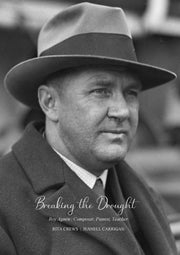Rita Crews & Jeanell Carrigan
Published by Wirripang Media (2022)
ISBN 978-1-876829-84 1
A new publication on the early Australian composer, Roy Agnew (1891-1944) is most welcome. This oft-neglected figure in Australian music enjoyed a diverse career as a piano and composition teacher, pianist, composer, and broadcaster.
Co-authors, Dr Rita Crews OAM and Dr Jeanell Carrigan AM have produced a very readable account which is engaging, benefiting our understanding of early composition, the social and cultural aspects of the time, and musical endeavour in this country.
Throughout his relatively short life, Roy Agnew gained the attention of many teachers and performers across the world.
The respected British music critic, Neville Cardus CBE stated in 1944 that Agnew “was easily the most distinguished of Australia’s composers”. He was considered ahead of his time, and his stylistic approach was often described as being very modern, “a composer of strikingly original music”. Whilst he adored the music of Chopin and Debussy, Agnew’s style had reminiscences of Scriabin.
Agnew was also a superb pianist, who enjoyed performances throughout Australia and in England, where he undertook study. With lessons in composition from Alfred Hill, his considerable output was mostly for solo piano. His music was championed by many pianists, most notable being Benno Moiseiwitsch, Walter Gieseking, Alexander Sverjensky, Eunice Gardner, Gordon Watson, Muriel Cohen, and Eileen Joyce amongst others, and more recently by Larry Sitsky AO, John Martin, Tamara Anna Cislowska, Stephanie McCallum and Jeanell Carrigan.
The book is divided between biographical chapters detailing his early life, family life (with much input via interviews and archival material), study years, broadcasting, and performance career, including a discussion (rather than an in-depth analysis) of his compositions. This discussion of his work is, at times, analytical and descriptive, delving into structure, harmonic and melodic ideas, and character.
Along with his solo piano music which numbers 70 pieces, Agnew wrote duets, a smattering of ensemble music, songs, a symphonic tone poem (bearing the title Breaking the Drought) and a now-lost Anzac Symphony.
Much of the music quoted has notational excerpts, as well as QR codes, which enable the reader to listen to performances or segments of the works discussed. This is a highly innovative inclusion. allowing the reader to engag directly with the composer’s music through an aural dimension. The performances serve to support the written text and musical excerpts, as well as tempt the teacher and student of piano to explore the music of this fine early Australian composer more fully.
Not only was Agnew a significant composer, and a radio broadcaster, performing on air for Australian and British radio audiences. He hosted regular programmes on ABC. He gave to his listeners insight into the world of early twentieth century music, albeit with British and Euro-centric influence.
His teaching at such iconic places as Palings in Sydney mark him as a distinguished person (note that at that time, the Sydney Conservatorium had not come into being).
The book has excellent referencing and indexes, which are enormously helpful not only for the avid reader, but also for the serious musician. Well-researched, the book captures the significant points in Agnew’s life and career. It is well-documented with photographs, concert programmes and musical extracts that underpin the narrative. It is commendable that not only this monograph now exists, but that the music of Roy Agnew is still available from this publisher.

